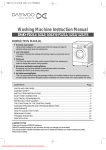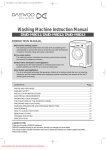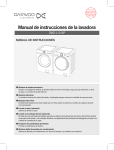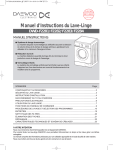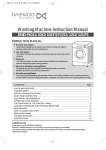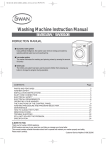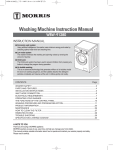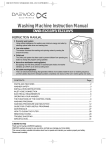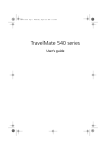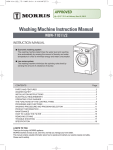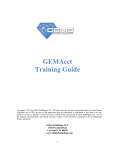Download Daewoo DWD-UD121X Series Instruction manual
Transcript
사양 확인 및 배포 2008.11.27 리)생산기술팀 Washing Machine Instruction Manual DWD-M1031 INSTRUCTION MANUAL " Economic washing system The washing machine determines the water level and washing time automatically by sensing the amount of laundry and water temperature in order to minimize energy and water consumption. " Low noise system The washing machine minimizes the spinning noise level by sensing the amount of unbalance of laundry. " Nano-silver sterilization washing(Option) By applying very fine silver particles on essential parts inside, the washer sterilizes up to 99.9% as is done by boiling wash. CONTENTS Page PARTS AND FEATURES.................................................................................................................2 WASHER SAFETY...........................................................................................................................3 INSTALLATION INSTRUCTIONS ....................................................................................................4 ELECTRICAL REQUIREMENTS .....................................................................................................6 OPERATING YOUR WASHER ........................................................................................................6 THE FUNCTIONS OF THE CONTROL PANEL...............................................................................8 PROGRAMS AND FUNCTIONS ......................................................................................................9 WASHING PROCEDURE AND PROGRAM SELECTION.............................................................10 MAINTENANCE .............................................................................................................................12 HOW TO CLEAN THE FILTER ......................................................................................................13 REMOVING STAINS ......................................................................................................................14 TROUBLE SHOOTING ..................................................................................................................15 SPECIFICATION ............................................................................................................................16 A NOTE TO YOU Thank you for buying a DAEWOO appliance. DAEWOO washers are easy to use, save time, and help you manage your home better. This manual contains valuable information about how to operate and maintain your washer properly and safely. Please read it carefully. Downloaded From WashingMachine-Manual.com Manuals PARTS AND FEATURES The parts and features of your washer are illustrated on the page. Become familiar with all parts and features before using your washer. NOTE The drawings in the book may vary from your washer model. They are designed to show the different features of all models coverd by this book. Your model may not include all features. INLET HOSE(HOT) (OPTION) INLET HOSE (COLD) DETERGENT CASE POWER CORD CONTROL PANEL DOOR HOSE DRAIN COVER PUMP ADJUSTABLE LEG Accessories Inlet hose (Cold: 1EA, Hot: 1EA) Manual Sticker holder (3EA) 2 Downloaded From WashingMachine-Manual.com Manuals Guide Hose Drain (Option) WASHER SAFETY Save these instructions Your safety is important to us. To reduce the risk of fire, electrical shock, or injury when using your washer adhere to the following basic precautions. Read all instructions before using your washer Please ... • Have only a qualified person install, repair, or replace parts on washer. • Maintain washer properly. • Protect washer from the weather and keep it where the temperature will not fall below freezing. • Do not install the washer at a place of extremely high humidity. It could cause an electric shock or a short circuit. • Connect washer to the correct outlet, electrical supply, water supply, and drain supply. • Flammable fluids (dry-cleaning solvents, kerosene, gasoline, etc.) should not be used or stored in or near your washer. Do not add flammable fluids to your wash water.These substances give off vapors that can create a fire hazard or explosion. • After starting a cycle, do not reach into the washer until all motions stop. • Do not tamper with the controls. • The appliance is not intended for use by young children or infirm persons without supervision. • If the supply cord is damaged, it must be replaced by the manufacturer, or its service agent or a similarly qualified person in order to avoid a hazard. • If the appliance is supplied from a cord extension set or electrical portable outlet device it should be positioned so that it is not subjected to splashing or ingress of moisture. Understanding your responsibilities • Do not use chlorine bleach and ammonia or acid(such as vinegar or rust remover) in the same wash. Hazardous fumes can form. • Unplug power supply cord before attempting to service your washer. • Do not wash fiberglass material. Small particles can stick to fabrics washed in following loads and cause skin irritation. • Do not spray water on the control panel of the washer. It could cause fire or an electric shock. • In case of the dual valve model, if you connect only one water inlet valve, the water leakage from other water inlet valve(unconnected) can occurs. • This appliance must be grounded. To avoid electrical shock, use a metal pipe for the ground connection. 3 Downloaded From WashingMachine-Manual.com Manuals INSTALLATION INSTRUCTIONS Removing transit bolts 1. Before operating the washer, remove the transit bolts(3ea) along with the rubber. • If the bolts are not removed, it may cause heavy vibration, noise and malfunction. 2. Unscrew the 3 bolts with the 10mm hex wrench or spanner or cross-tip screwdriver. Keep the 3 bolts for a later time. • When the appliance is transported, transit bolts will be re-used. 3. Close the holes with sticker holders supplied. Location of washer • Check location where the washer will be installed. Make sure you have everything necessary for correct installation. • Do not place or store your washer below 0°C (32°F) to avoid any damage from freezing. • Do not place or store laundry products on top of washer at any times. Drain Hose • Install the washer on the horizontal solid floor. Washer If the washer is installed on an unsuitable floor, it could make considerable noise, vibrate severely and cause a malfunction. If the washer is not level, adjust leg up or down for horizontal installation. Laundry • Ventilation openings must not be obstructed by carpeting when the washer is Tub installed on a carpeted floor. approx. 2cm • Leave some space (right & left : 2cm, rear : 10cm). • In case of built-in installation, the distance between top of the washer and bottom of upper plate should be at least 3mm. Inlet hose connection • The washer should be connected to the water mains using new hose set and old hose sets should not be reused. • In case of only one water inlet valve, connect the inlet hose to the cold water tap. 1. Connect the inlet hose to the water tap tightly. 2. Connect the inlet hose to the water inlet valve tightly. • Periodically check the tightness of the inlet hose. • Make sure that the inlet hose is not kinked or folded and that it is not crushed. 4 Downloaded From WashingMachine-Manual.com Manuals Drain system • Never forget to install drain hose before operating your washer. • Open the packing box, and the drain hose is tied at backside of washer. • If you use the laundry tub, Top of laundry tub must be at least 60cm high and no higher than 100cm from bottom of washer. • When installing the drain hose to tub(sink), secure it tightly with a string. • Proper securing of the drain hose will protect the floor from damage due to water leakage. • When the drain hose is too long, do not force it back into the washer. This will cause abnormal noise. Level adjustment 1 If the washer is installed on an unsuitable floor, it could make considerable noise, vibrate and cause a malfunction. 2 Adjust the level of washer using adjustable legs. • Please check if there is any gap between the four adjustable legs and the floor. • Adjust the level of washer by turning adjustable legs. And make it sure that there is no swaying of washer. • After the adjustment is finished, turn the fixing nuts up tightly so that the washer maintains the adjustment. 3 Make it sure that the washer does not sway when you press down the four corners of the washer's top plate. NOTE There should be no swaying of washer and all the adjustable legs should stick to the floor closely. 5 Downloaded From WashingMachine-Manual.com Manuals Fixing Nut adjustable leg ELECTRICAL REQUIREMENTS WARNING Electrical shock hazard : Failure to follow these instructions could result in death or serious injury. • Electrical earth is required on this washer • If it does not fit the outlet, have a proper outlet installed by a qualified electrician. • Don’t earth to a gas pipe. • Don’t change the power supply cord plug. • Check with a qualified electrician if you are not sure the washer is properly earthed. Recommended earthing method C B A For your personal safety, this washer must be earthed. This washer is equipped with a power supply cord ‘A’ having a earthing plug ‘B’. To minimize possible shock hazard, the cord must be plugged into a mating earthing-type wall receptacle ‘C’. If a mating wall receptacle is not available, it is the personal responsibility and obligation of the customer to have the proper earthed wall receptacle installed by a qualified electrician. OPERATING YOUR WASHER To obtain the best washing results, you must operate your washer properly. This section gives you this important information. Preparing clothes for washing • Close zippers, snaps, and hooks to avoid snagging other items. Remove pin, buckles, and other hard objects to avoid scratching the washer interior. • Empty pockets and pull them inside out. • Turn down cuffs and turn synthetic knits inside out to avoid pilling. • Tie strings and sashes to avoid tangling. • Treat spots and stains. (See “Removing stains” on page 21) 6 Downloaded From WashingMachine-Manual.com Manuals Sorting • Separate heavily soiled items from lightly soiled ones, even if they would normally be washed together. • Separate dark colors from light colors, colorfast items from non-colorfast item. Soil (Heavy, Normal, Light) Color (White, Lignts, Darks) Lint (Lint producers, Collectors) Separate clothes according to amount of soil. Separate white clothes from colored clothes. Wash lint producers and lint collectors separately. Loading • Mix large and small items in each load. Load evenly to maintain washer balance. An unbalanced load can make the washer vibrate during spin. • Reduce wash time when using a small load size setting. Load with only a few small items needs less wash time. • Use a large load size setting to reduce wrinkling with permanent press clothes and some synthetic knits. These items should have more room to move in the water than heavy items. (towels, jeans) • Drop items into washer loosely. Items should move easily through wash water for best cleaning and wrinkle-free results. • Load washer properly and select correct load size setting. Overloading and selecting a setting too small for the wash load can : - Cause poor cleaning - Increase wrinkling - Create excessive lint - Wear out items faster (because of pilling) Adding detergent 1 Detergent case 2 Adding fabric softener • If desired, add measured liquid fabric softener to the softener inlet. • Pour liquid fabric softener into the dispenser using the amount recommended on the package. • Do not exceed the maximum fill line. Overfilling can cause early dispensing of the fabric softener which could stain clothes. • Do not open the detergent case when water is supplied. • Avoid pouring fabric softener directly on the clothes. Pre wash Main wash Fabric softener • Please use only the powder detergent for the front loader washing machine. • Please use the proper amount of detergent in conformity with the instruction of the detergent manufacturer. • A use of a large amount of detergent more than the recommended amount can cause many soapsuds and the overload to the motor. In addition to, this will deteriorate the washing and rinse performance. • If too much detergent used, it can occur that the detergent directly falls down to the inside cavity. In this case, remove the detergent case and clean the cavity after washing cycle is finished. (See page 13) 7 Downloaded From WashingMachine-Manual.com Manuals THE FUNCTIONS OF THE CONTROL PANEL Program selector Indicator light For switching the washing machine on and off and for selecting the program. The respective indicator lights up, When the required program segment runs or “Time delay” is selected. Can be rotated in both direction. Even if the program selector rotates while the program is running, the program is not changed (except for off ) . (All program is electronically controlled by PCB) Time delay To pre-engage time for washing. As the button is pressed, the delayed time is repeated as following; 2hours or 3hours ➝ 6hours ➝ 9hours ➝ max 12hours Button for options Start/Hold button (in addition to the program if required) For starting the washing cycle (program must have been selected) Intensive wash Extended washing time. Spin button Rinse + Extra rinse cycle. Rinse Hold No final spin cycle As button is pressed, spin rpm is repeated as following 800 ➝ 1000 ➝ 600 ➝ 800 • Combination of additional option is possible. *Warning If value of unbalance is extremely high, spin speed can't reached that r.p.m of selected by spin button. • The indicator lamp of the buttons lights up if options are active. • Switch off option : Press button again. 8 Downloaded From WashingMachine-Manual.com Manuals PROGRAMS AND FUNCTIONS Programs and functions Program Fabric type Proper Temp. Degree of soiling Colorfast garments (shirts, night dresses, pajamas…) and lightly soiled white cotton (underwear…) Cold 30°C 40°C Lightly soiled 60°C Normally to heavily soiled Option Intensive wash Rinse+ Rinse hold Max. Load Rating 60°C/Pre Heavily soiled White cotton, linen and sheet…. 95°C Normally soiled Colored laundry. 30°C Lightly soiled Intensive wash Rinse+ Rinse hold 1.0kg Colored laundry. (shirts, underwear, towels…) 30°C Normally soiled Intensive wash Rinse+ Rinse hold 2.5kg Made of polyamide, acrylic, polyester (synthetic or blended fabrics). Cold 30°C 40°C 60°C Lightly soiled 60°C/Pre Normally to heavily soiled First Check if laundry is washable. Intensive wash Rinse+ Rinse hold Machine washable wool or wool-rich textiles or silk. Cold 30°C 40°C Lightly soiled Intensive wash Rinse+ Rinse hold ‘Hand wash” marked delicate and wool laundry 30°C Lightly soiled Intensive wash Rinse+ Rinse hold Delicate, washable laundry easily damaged (silk, satin…). Cold 30°C 40°C Lightly soiled Intensive wash Rinse+ Rinse hold 2.5kg 1.0kg 9 Downloaded From WashingMachine-Manual.com Manuals Remark 1.0kg Short program (Fast washing time) Rinse : Rinse cycle with subsequent spin cycle for rinsing hand-washed items. Spin : Spin cycle after a program with setting “Rinse hold” is finished or for spinning hand-washed washing. Washing and rinsing water is drained before the spin cycle Drain : Water is drained after program with setting “Rinse hold” is finished. Intensive wash : The washing time is extended so that highly soiled laundry is washed more intensively. Rinse+ : Additional rinsing of laundry. Program duration and rinsing water is extended accordingly. This help to remove residuary traces of detergent and recommended in area with very soft water. Rinse Hold : For delicate textiles and net curtains. All program can be carried out without the final spin cycle. The laundry is left in the final rinsing water. Before the laundry is unloaded, the “Drain” or “Spin” must be run by using program selector. WASHING PROCEDURE AND PROGRAM SELECTION Washing Procedure • Turn the program selector to the desired program The indicator light of Start/Hold button is on. • If required, press the button(s) for option(s). The indicator light of the selected option button is on. • If you select 'Rinse Hold' button, led of 'Rinse Hold' flicker continually and press 'Hold' button immediately, seleted 'Spin' course. When you press 'Start' button, spin sequence begin. You can take out laundry after spin course finish. • Press the Start/Hold button. The selected program starts and the indicator light of Start/Hold button twinkle. 10 Downloaded From WashingMachine-Manual.com Manuals Changing the program If you have accidentally selected the wrong program, follows next procedure. • Press the Start/Hold button. The selected program stops and the indicator light of Start/Hold button is not twinkle but on. • Turn the program selector to OFF and reselect the desired program by using the program selector. • If required, select the option(s). And press the Start/Hold button. The newly selected program starts Using Time delay Firstly, you select the desired program and option(s). • Pressing the “Time delay select the delayed time. ” button, • Press the “Start/Hold” button. The indicator light of “Start/Hold” is off and the indicator light corresponding to the selected time is on. • The displayed time shows program finishing time. ❋ Canceling Time delay • Press the “Start/Hold” button. (Then the indicator light of “Start/Hold” is on.) • Turn the program selector to OFF. After washing When the washing is complete, the indicator light of Start/Hold button is not twinkle but on. • Turn the program selector to OFF . 11 Downloaded From WashingMachine-Manual.com Manuals MAINTENANCE Proper care of your washer can extend its life. This section explains how to care for your washer properly and safely. Cleaning your washer Exterior Interior Wipe up detergent, bleach, and other spills with a soft, damp cloth or sponge as they occur. Occasionally wipe the outside of the washer to keep its looking like new one. Clean interior with 250ml of chlorine bleach mixed with 500ml of detergent. Run washer through a complete cycle. Repeat this process if necessary. Do not put sharp or metal object in your washer, or they can damage the finish. Check all pockets for pins, clips, money, bolts, nuts, etc. Do not lay these objects in your washer after emptying pockets. Winter storage or moving care Install and store your washer where it will not freeze. Because some water may stay in the hoses, freezing can damage your washer. If you store or move your washer during freezing weather, winterize it. To winterize washer To use washer again • Turn off the water tap. • Disconnect inlet hoses and drain the water of inlet hoses. • Run the washer on the drain and spin cycle setting. • Unplug the power supply cord. • Flush water pipes and hoses. • Reconnect water inlet hoses. • Turn on water faucet. • Reconnect power supply cord. Non-use or vacation care Operate your washer only when you are at home. If you are on vacation or don’t use your washer for an extended period of time, you should: • Unplug the power supply cord or turn off eletrical power to the washer. • Turn off the water supplier to the washer. This helps avoid accidental flooding (due to a water pressure surge) while you are away. 12 Downloaded From WashingMachine-Manual.com Manuals HOW TO CLEAN THE FILTER Cleaning the water inlet filter • Clean the filter when water leaks from the water inlet. 1 Turn off the water tap. 2 Separate the inlet hose. 3 Pull out the inlet filter. Clean the inlet filter with the brush 4 Connect the inlet hose Cleaning the drain filter • This drain filter is used to screen the foreign stuffs such as threads, coins, pins, buttons etc.. • If the drain filter is not cleaned at proper time(every 10 times of use), drain problem could be caused. CAUTION : Be careful when draining if the water is hot. 1. Open the cover-pump(1) by using coin. Separate the cover-pump(1) from the washing machine. 2. Install the cover-pump(1) to the lower frame(2). Open the pump-filter(3) slowly and allow the remaining water to flow into a suitable container. 3. Remove foreign objects from the pump-filter(3) and clean the interior. Close the pump-filter(3) and replace the cover-pump(1). 3 1 2 1 1 3 Cleaning the detergent case • In case of residual detergents or fabric softeners have accumulated ; - it should be cleaned with a jet of running water. - If necessary, it can be removed completely from the washing machine. Push point 1 Pull-out 2 Push and pull again • Detergents can be also accumulate the inside cavity. In this case, the inside cavity should be cleaned with a brush. • After cleaning, replace the detergent case and run Rinse cycle without laundry. 13 Downloaded From WashingMachine-Manual.com Manuals REMOVING STAINS Stained, heavily-soiled, or greasy items may need to be prewashed or soaked for best results. Soaking helps remove protein-type stains like blood, milk or grass. Prewashing helps loosen soil before washing. Stain removal rules • Use warm water for soaking or prewashing stained laundry. Hot water can set stains. • Most stains are easier to remove when they are fresh. • Before treating any stain, find out what kind of stain it is, how old the stain is, what kind of fabric it is, and whether the fabric is colorfast. (Check the care label) • Washing and drying can set some stains. • Start with cold or warm water. Hot water can set some stains. • When bleach is recommended, use a bleach that is safe for the fabric. • Put the stained area face down on a paper towel or white cloth. Apply the stain remover to the back of the stain. This forces the stain off fabric instead of through it. Stain removal guide STAIN Blood Chewing gum Cocoa, Chocolate Coffee Cream/Milk Ice cream Deodorant Egg Fabric/Softener Fruit stains Grass Grease and oil Iron or rust Lipstick Mildew Mud Paint-oil based Paint-water based Scorch marks TO REMOVE Rinse immediately in COLD water. If stain remains, soak in cold water with an enzyme prewash. Use ice in plastic bag to harden the gum. Scrape off what you can and the sponge with white spirits. Sponge with COLD water and soak in an enzyme prewash. If stains persist, rub in a little detergent and rinse in cold water. Blot up quickly and rinse out in COLD water. Rub in a little detergent and wash in the maximum temperature allowed for the fabric type. Rinse in COLD water and wash normally. If stain is still apparent, sponge with white spirits. Rub affected area with white vinegar and then rinse out in COLD water. Sponge with white spirits. Treat stiffened areas with enzyme prewash. Soak in a COLD enzyme prewash, rinse and wash normally. Rub affected area with bar soap and wash normally. Treat as soon as possible by sponging with COLD water. Rub a little detergent on the stain and wash normally. Sponge with white spirits. Rub in an enzyme prewash and wash as normally. Lay the affected area face down on an absorbent cloth and work from the back. Sponge with white spirits or dry cleaning fluid. Wash normally. Apply lemon juice and salt and place in the sun. Wash normally. Sponge with white methylated spirits and wash normally. Wash in WARM water and detergent. Moisten area with lemon juice, dry in the sun and wash normally. If stain persists and the fabric allows, use a bleach. Brush off any dry mud. Rinse in cold water. If stain persists rub in a little detergent and wash normally. Scrape off any fresh paint and sponge with a non flammable dry cleaning fluid and wash normally. Treat while still wet, rinse in WARM water and wash normally. Dampen a cloth with hydrogen peroxide, lay it over the affected area and press with a fairly hot iron. 14 Downloaded From WashingMachine-Manual.com Manuals TROUBLE SHOOTING Most problems are easily solved if you understand the cause. Check the following list for problem before calling for service. Problem Cause Program dose not start. Plug is loose or not plugged in. Power failure. Loading door is not closed. Water dose not enter the washing machine. Washing machine is not drain. Washing machine is not spin. Spin result is unsatisfactory. Foam come out of the detergent case. Serious noise and vibration Program is not selected. Start/hold button is not pressed. Water tap is not turned on. Inlet hose is kinked or folded. Filters is blocked in water inlet filter. Drain hose is kinked or clogged. Pump filter is clogged. The amount of laundry is too small. The laundry is unbalanced. Drain hose is placed over 1m above the floor. Too much detergent or unsuitable detergent used. Transit bolts are not removed. Washing machine is installed on uneven floor. Washing machine is not leveled. Solution Insert plug tightly. An interrupted program will be resumed when the power return. Check whether laundry is trapped in door. Close the loading door. (a click should be heard) Select the desired program. Press the Start/hold button. Turn the water tap on. Straighten the inlet hose. Clean the water inlet filter. Straighten and clean the drain hose. Clean the pump filter Add the laundry to balance. And repeat the Spin cycle. Rearrange the laundry. And repeat the Spin cycle. If articles of heavy clothing (e.g. bath robe) are loaded, washing machine may skip or stop the spin cycle. Place the drain hose under 1m above the floor. Repeat the Rinse cycle. Remove the transit bolts Reinstall washing machine on even floor. Adjust the level of washing machine using adjustable legs. ■ DISPLAY ERROR MESSAGE MESSAGE ERROR IE WATER INLET ERROR OE DRAIN ERROR UE UNBALANCE ERROR LE DOOR OPEN ERROR CAUSE The water tap is closed. The filter of the valve inlet is clogged. The valve inlet is an inferior product or broke down. The water level sensor (sensor pressure) is an inferior product or broke down. The drain motor works during water supply. The PCB ASS’Y does not check the water level. The drain hose is kinked or clogged. The drain motor is an inferior product. The valve inlet works during drain. The water level sensor is an inferior product. The PCB ASS’Y does not check the water level. The laundry is concentrated to one side of the drum during spin. The Start/Hold button is pressed while the door is opened. The switch door lock is an inferior product. The PCB ASS’Y does not check the door lock. 15 Downloaded From WashingMachine-Manual.com Manuals SOLUTION Open the water tap. Clean the filter of the valve inlet. Change the valve inlet. Change the water level sensor (sensor pressure). Change the drain motor. Change the PCB ASS’Y. Clean and straighten the drain hose. Change the drain motor. Change the valve inlet Change the water level sensor. Change the PCB ASS’Y. Rearrange the laundry. Close the door. Change the switch door lock. Change the PCB ASS’Y. SPECIFICATION MODEL DWD-M1031 Power Consumption 220V~240V/50Hz (2000W) Dimension (mm) 595x440x850 (WxDxH) Maximum mass of textile (kg) 6 kg Unit Weight (kg) 54(Net) / 57(Gross) Standard Water Consumption 42" Spin Speed (RPM) 1000/800/600 Operating Water Pressure 0.03MPa ~ 0.8MPa (0.3kgf/cm2 ~ 8kgf/cm2) 16 Downloaded From WashingMachine-Manual.com Manuals ABOUT THIS MANUAL #$%$&'!()*+,$#*-!$'(. /0 123 456 789 :;<= >? @ A BCD E F G H I+*J&& N.!O&I*P IQNRSTUS V.!O&I*P IJIQOSTUS SW K L ML XTTY.TZ.S[Q\] B^ _` XW D a UW >W [W b c e d f 6D O*O&!ghi!jkS7lm TY.T7.T>Qt9-!Xl-![l-!Yl-!ul-!STl-!SSl-!S7lvhav!wx Yl TY.T7.TuQt9-!Yl-!ul-SSl-!S7lvhav!wx [l TY.T7.TuQSSl!hav!wx Sl TY.T7.SuQYl!hav!wx Sl TY.TZ.XXQYl-!STl-S7lvhav!wx Ul TY.TZ.XuQSTl-!S[l-S7lvhav!wx Ul TY.Tu.T>QS7lvhav!wx Sl TY.Tu.T[Qt9-!S7lvhav!wx Xl TY.ST.USQYlvhav!wx Sl!jha y:9 \]_`m TY.SS.X7QYl!hav!wx Sl nop #$%$&' @ A q r h ,*Pi ZUTQT77T!N+si ZUTQUZYY Downloaded From WashingMachine-Manual.com Manuals

















